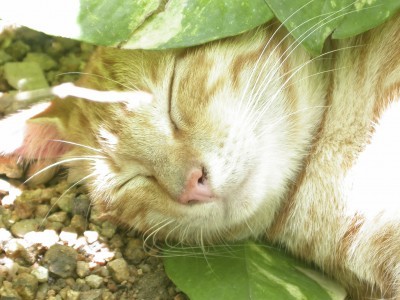






Okay, I probably know what you’re thinking… who wants cats in the garden? Well, if you already have outdoor cats or if your neighbor’s feline friend enjoys roaming about your property, then it’s inevitable that at some point they will visit (or have) the garden. Rather than fighting an unending battle of the cat-turf wars with multiple attempts at repelling these kitties, why not do the opposite and create a pet-friendly garden just for them. When placed in the right location, it may even thwart them from venturing into unwanted areas of your garden. Read on for tips on creating a cat-friendly garden.
My mother loves to garden but she also has a large assortment of cats too. Although these are largely indoor kitties, they have a designated area all their own outdoors in which they are free to roam about. Mom calls it the “cat palace.” This cat-friendly garden is fenced in so they cats cannot get out, so there’s no worry of predators getting to them or the cats venturing into dangerous areas, like the road. They are free to come in and out through the kitty door (just like many dogs have). Within its walls of safety are plenty of structures for climbing and plants that are safe for them to nibble on. They also have multiple dirt-filled areas in which to “relieve” themselves. Of course, this type of setup may not be for everyone, so here are some other cat-friendly garden ideas.
First and foremost, cats are naturally curious with a need for exploration. Choosing a location in the backyard just for them can help keep your furry friends appeased. They love to climb, hide and pounce. With this in mind you will want to include climbing structures, like cat posts, fencing and trees.
Give them some hiding places too, along with shade for those hot days lulling about. Shrubs are great for this and don’t forget some evergreen varieties too, not only for seasonal interest but for added cover in winter. Planting them close together can help create fun hiding spaces too, where they can pretend to stalk their prey (or each other), and pounce out to attack.
Create designated play areas for younger felines and don’t forget to include mounds of dirt, mulch or sand for them as well. Cats typically go potty in the same place, so this can help deter them from going into your prized garden spaces. Mulched pathways will also provide a soft landing. Active cats enjoy playing, so you can peak their interest by adding suitable toys attached to strings and tied to branches. Throw in a few balls and scratching posts too.
Just as the dog has a sheltered spot to go to, you can even include a “cat house” for your feline to hide in. Alternatively, placing the garden area near an outbuilding will give that added sense of security that some cats need.
Choosing plants for your cat’s garden space must be done with care. Hardy, but safe, plants is obviously an important consideration. And since cats enjoy chasing things, those that attract butterflies may be a good choice. In fact, attracting insects in the cat garden is a good thing in that you want to avoid using any toxic pesticides that could be harmful.
A number of plants may not be suitable for your feline and may even be poisonous, so choose your plants carefully. Here are some plants you can add to create safe gardens for cats:
While most vegetables are deemed relatively safe, the foliage of some, like potatoes and tomatoes, are not a good idea to have where you expect your furry friend to be roaming about. What is a safe veggie you can add to your cat’s garden?
Members of the cucurbit family, which includes cucumbers, squash and pumpkins, are safe for cats. The vining types are good choices for providing hiding spaces as well as hanging fruits to climb on or play with.
Runner beans can also be used in your cat-friendly garden to create secret hideaways and provide shade. You can even make a bean teepee for them! And if your cat nibbles on them, which in all likelihood they won’t, they are not considered toxic.
Copyright © www.100flowers.win Botanic Garden All Rights Reserved